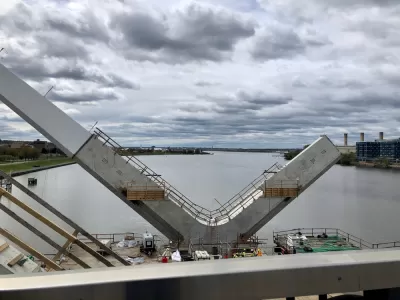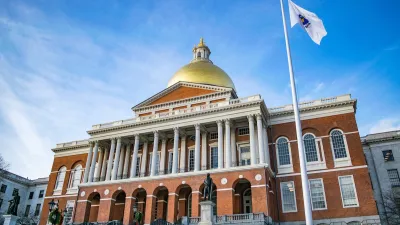The largest infrastructure project in D.C. history is opening this week—first to pedestrians and then to automobile traffic.

Luz Lazo and Michael Laris report on the debut of the new Frederick Douglass Memorial Bridge, which opened to the public on September 6 and replaced a 71-year-old bridge spanning the Anacostia River in Washington, D.C.
The new bridge is 1,445 feet long and cost $480 million—that latter figure making the new bridge the largest infrastructure project in the history of the District.
"The bridge is not finished. Vises hold up 2-by-4s as makeshift barriers on concrete lookout areas, and paving and connections aren’t complete on wide pedestrian pathways. But Monday’s bridge celebration — starting with a 5K run and walk led by Mayor Muriel E. Bowser — offered expansive views and the chance for many to consider a changing city," according to the article.
Vehicle traffic is expected to start crossing the bridge on Friday and Saturday of this week. "Runners, walkers and stroller-pushers began crossing the span about 9 a.m. Monday as an American flag waved from one of its towering white arches."
The article includes anecdotes and soundbites from the bridges debut on Labor Day. Lazo and Laris also sum up the relevance of the bridge's reopening relative to the larger cultural context and planning history of the District thusly:
The opening of the distinct structure with parallel arcs marks a milestone in the vision to turn the South Capitol Street Corridor into the grand boulevard that Pierre L’Enfant envisioned in his original plan for the nation’s capital. L’Enfant identified the corridor as a symbolic gateway into the District’s monumental core, one that has not been realized as the road maintained a freeway-type configuration that lacked adequate pedestrian and cycling facilities.
FULL STORY: New $480 million Frederick Douglass Memorial Bridge begins opening week with a Labor Day celebration

Trump Administration Could Effectively End Housing Voucher Program
Federal officials are eyeing major cuts to the Section 8 program that helps millions of low-income households pay rent.

Planetizen Federal Action Tracker
A weekly monitor of how Trump’s orders and actions are impacting planners and planning in America.

The 120 Year Old Tiny Home Villages That Sheltered San Francisco’s Earthquake Refugees
More than a century ago, San Francisco mobilized to house thousands of residents displaced by the 1906 earthquake. Could their strategy offer a model for the present?

HSR Reaches Key Settlement in Northern California City
The state’s high-speed rail authority reached an agreement with Millbrae, a key city on the train’s proposed route to San Francisco.

Washington State Legislature Passes Parking Reform Bill
A bill that would limit parking requirements for new developments is headed to the governor’s desk.

Missouri Law Would Ban Protections for Housing Voucher Users
A state law seeks to overturn source-of-income discrimination bans passed by several Missouri cities.
Urban Design for Planners 1: Software Tools
This six-course series explores essential urban design concepts using open source software and equips planners with the tools they need to participate fully in the urban design process.
Planning for Universal Design
Learn the tools for implementing Universal Design in planning regulations.
Ada County Highway District
Clanton & Associates, Inc.
Jessamine County Fiscal Court
Institute for Housing and Urban Development Studies (IHS)
City of Grandview
Harvard GSD Executive Education
Toledo-Lucas County Plan Commissions
Salt Lake City
NYU Wagner Graduate School of Public Service





























